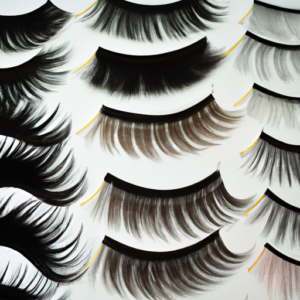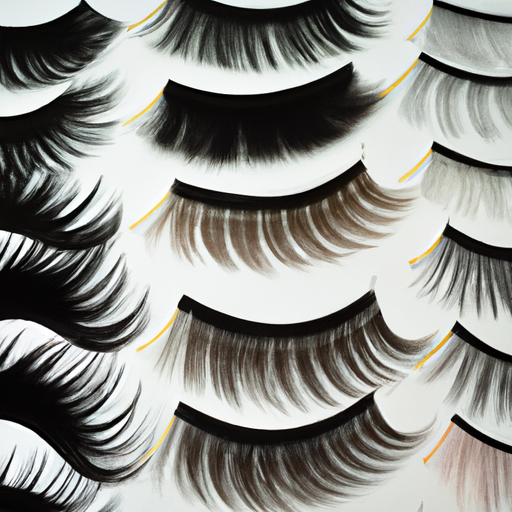Howdy, y’all! Let’s get to know false eyelashes
Well, hello there! I’m glad we could sit down and talk about one of my favorite beauty topics – false eyelashes! False eyelashes are an essential item in any makeup kit, and they are widely used to enhance the beauty of eyes. False eyelashes come in various shapes, sizes, and designs. They can be simple and natural-looking or dramatic and bold. So, what exactly are false eyelashes?
False eyelashes are artificial eyelashes that are glued to your natural lashes to enhance their look. Normally, they are made from synthetic fibers, human hair, or animal fur, such as mink fur. The materials used to make false eyelashes can have an impact on their quality, price, and comfort level. Let’s dive a little deeper into the materials used to make them, shall we?
Let’s talk about the different materials used in false eyelashes! When I first got into wearing falsies, I had no idea that there were so many options. You’ve got synthetic fibers, human hair, and even mink fur. Each material has its own advantages and disadvantages, so it’s important to know what they are before choosing a pair.
Throwing It Back to Synthetic Fibers
Synthetic fibers are the OG material used in false eyelashes. They’re made of plastic and come in a variety of shapes, sizes, and styles. Synthetic lashes are great for beginners because they’re affordable and readily available. They’re also relatively durable and can be reused multiple times. However, synthetic lashes can be uncomfortable to wear and feel heavy on the eyes.
Human Hair, More Natural Look and Feel
For those looking for a more natural look and feel, human hair lashes are a popular choice. These lashes mimic the texture of real eyelashes and blend in easily with your natural lashes. They’re also more comfortable to wear and can be reused multiple times like synthetic lashes. However, they’re more expensive than synthetic lashes and the curl can fall out over time.

Mink fur lashes are considered to be the most luxurious type of false eyelashes. They’re soft, fluffy, and have a natural look to them, making them a popular choice for special occasions or photoshoots. Because they’re made from real animal fur, they’re also more expensive than both synthetic and human hair lashes. Additionally, using animal fur can be a drawback for some people.
If you have sensitive eyes, it’s important to note that the materials used in false eyelashes can affect your comfort levels. Some people may experience allergic reactions to certain materials. Check out this article for more information on wearing false lashes with sensitive eyes.
3. Advantages of Different Materials: Why I Prefer Mink Fur
When it comes to choosing false eyelashes, there are a variety of materials to choose from. Personally, I prefer mink fur lashes for several reasons. First, they are lightweight and have a natural look and feel, which is important for me since I wear them daily. They are also durable and can be reused multiple times, which saves me money in the long run. Plus, mink fur lashes hold their shape well and are easier to manipulate when applying them.
While synthetic fiber lashes are more affordable, they often look less natural and can be irritating to some people’s eyes. Human hair lashes, on the other hand, can cost more than mink fur lashes and may not hold a curl as well. Mink fur lashes strike the perfect balance between natural look and durability.
Another advantage of mink fur lashes is their versatility. They can be tailored to fit different eye shapes and can be customized with different lengths and styles. Whether I want a subtle boost to my natural lashes or a dramatic look for a night out, mink fur lashes offer endless options.
Finally, a bonus benefit of mink fur lashes is that they are cruelty-free. The fur is collected during the animals’ natural shedding process, so there is no harm in the production of these lashes.
All in all, while each material has its own unique set of advantages, mink fur lashes are my top choice for their natural look and feel, durability, versatility, and cruelty-free production.
What’s the catch? Disadvantages of Different Materials
Okay, let’s not sugarcoat it. False eyelashes can have drawbacks too, depending on the material used. Here are some potential downsides to keep in mind.
Synthetic Fibers
When it comes to synthetic fiber false eyelashes, one of the main disadvantages is their stiffness. They may not move as naturally as human hair or mink fur lashes, which can make them look less realistic. Additionally, synthetic lash bands can sometimes feel uncomfortable or irritating on the eyelid, especially if they are poorly made or too thick. There’s also the matter of environmental impact, as synthetic fibers are not biodegradable and can contribute to pollution.
Human Hair
While human hair false eyelashes can look very natural and blend seamlessly with your own lashes, there are a few downsides to be aware of. For one thing, they are not cruelty-free, as the hair is typically sourced from a hair salon or other source. Additionally, because human hair is a natural material, it may not be as durable as synthetic fibers or mink fur lashes. They also tend to be more expensive than synthetic lashes, which could be a drawback for some people.
Mink Fur
While mink fur lashes are often marketed as a luxury option, they do come with some potential downsides. For starters, they are the least ethical option, as the fur is typically obtained through cruel methods such as fur farming or trapping. Additionally, mink fur lashes may not be suitable for those with allergies or sensitive skin, as the fur can contain dander or other allergens. They also tend to be more expensive than synthetic or human hair lashes, which may be a concern for some people.
So, there you have it – a rundown of some of the drawbacks of each false eyelash material. Ultimately, it’s up to you to decide which factors are most important to you and choose the option that fits your needs and values best.
My Final Thoughts on False Eyelashes
Well folks, that’s my two cents on the world of false eyelashes. After some research and personal experience, I’ve come to the conclusion that the material used definitely makes a difference in terms of both pros and cons.
Synthetic fibers may be the most affordable option, but they can also look the most obviously fake. Human hair, while more natural-looking, has a tendency to wear down quickly and may require more maintenance. And as for the controversial mink fur option, I can see why some people might want to avoid it for ethical reasons.
But ultimately, the decision of which material to go with comes down to personal preference and priorities. Do you want a more natural look, or are you okay with a more dramatic one? Are you willing to splurge for higher-quality lashes, or are you looking to save some cash?
Regardless of what you choose, just make sure to follow proper application and removal techniques to avoid any damage to your natural lashes. And always keep in mind that false eyelashes are just that – false. Embrace your own lashes, whether they’re long and full or short and sparse.
